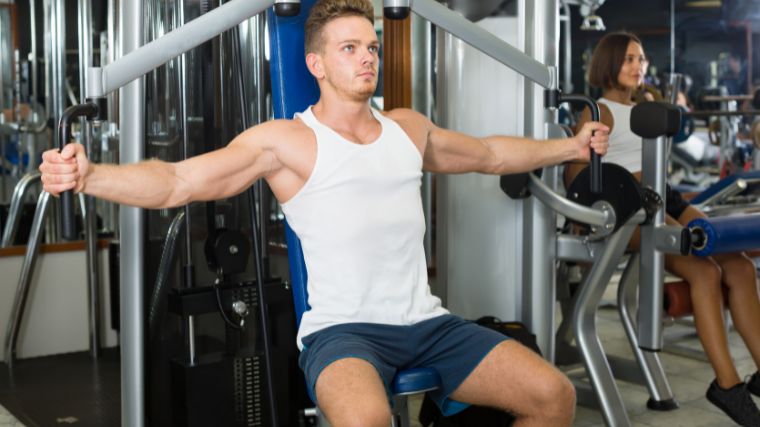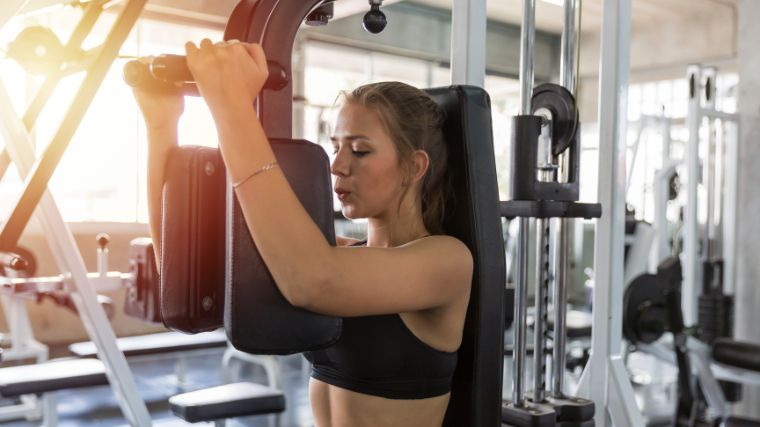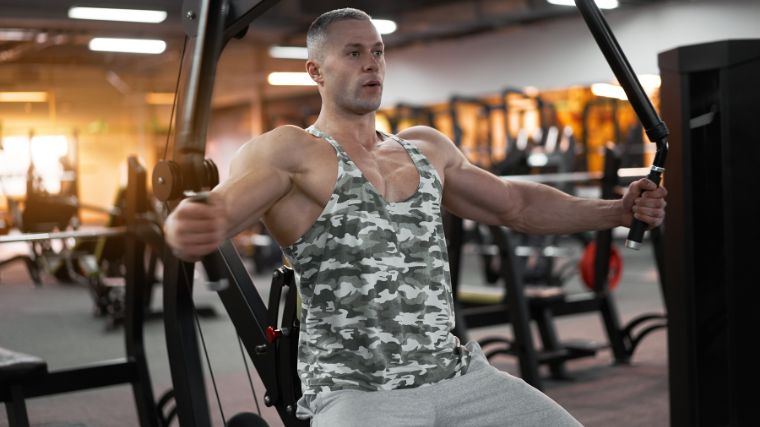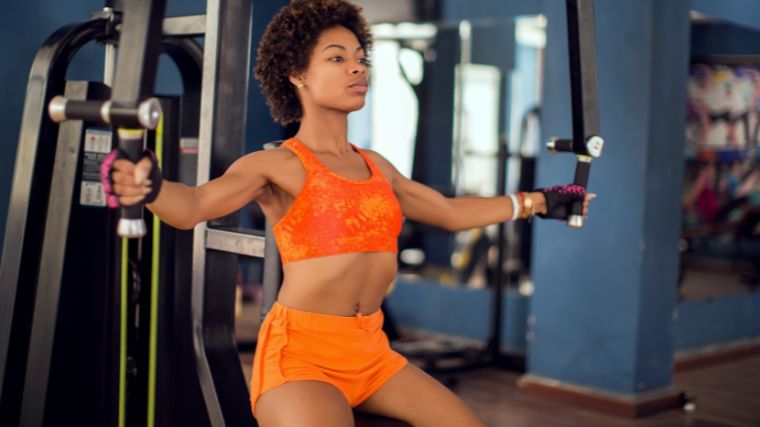If you asked someone what their favorite chest-crafting exercise is, they’ll probably be inclined to point you to any number of pushing or pressing exercises that necessitate the use of either a barbell, a pair of dumbbells, or the floor.
Their heart is in the right place, but the standard pushing motion is unable to encapsulate everything that your chest is designed to accomplish. This is especially true of your chest’s capacity to help you wrap your arms around an object and squeeze in an inward direction.

To broaden your chest in a way that supports its ability to apply crushing force, you should give the seated chest flye its due consideration. The seated chest flye provides your pectoral region with consistent resistance throughout its full range of motion.
- How to Do the Seated Chest Flye
- Seated Chest Flye Variations
- Seated Chest Flye Alternatives
- Seated Chest Flye Sets and Reps
- Benefits of the Seated Chest Flye
- Muscle Worked by the Seated Chest Flye
- Who Should Do the Seated Chest Flye
- Common Seated Chest Flye Mistakes
- Frequently Asked Questions
How to Do the Seated Chest Flye
At face value, performing the seated chest flye may appear to be as simple as sitting in a chair and cranking away at the pads or handles provided by the machine. However, there are some important preparatory steps that should be taken to ensure that you’re getting the most out of the exercise.
Step 1 — Set Your Body

/ Shutterstock
Arrange yourself on the seated chest flye machine so that your feet sit comfortably on either the floor or the machine’s foot rest. Retract your shoulder blades so that they rest on the support pad while your chest protrudes in front of you.
Coach’s Tip: To ensure that your chest achieves a full range of motion , preset the forearm pads or handles so that their resting point extends your arms slightly wider and further back than your essential range of motion for this exercise.
Step 2 — Set Your Arms

Place your arms on the machine’s pads or handles — whichever is provided — so that your upper arms run parallel to the floor.
Coach’s Tip: While your arms are in their backmost position, you should feel a natural, healthy stretch throughout the muscles of your chest.
Step 3 — Squeeze Your Arms Together

While maintaining the forward positioning of your chest and the retraction of your shoulders, manually initiate a contraction from your chest and drive your arms together in front of your body. Pause and squeeze your chest muscles at the peak of the movement.
Coach’s Tip: Resist the urge to drive your head forward or downward to initiate the pull. If this is necessary to move the pads, you are probably using too much weight.
Seated Chest Flye Variations
While the seated chest flye is a staple machine in several gyms, there are no guarantees that your gym of choice will have one. Beyond that, it is indeed the rare household that has one of these specialized devices simply sitting around.
[Read More: Build a Titanic Torso with These Bodybuilding Chest & Back Workouts]
Fortunately, there is an abundance of exercise variations capable of accomplishing the seated chest flye’s core mission of taking the chest through its natural hugging motion without an excessive contribution from the triceps.
Dumbbell Chest Flye
- Lie down on a bench with your head facing up, and a dumbbell in each of your hands.
- Holding the dumbbells in a neutral grip, lower them to your sides by drawing your shoulders back and keeping your arms straight aside from a slight bend in the elbows.
- Squeeze the muscles of your chest to bring your hands back together and raise the weight back to its starting position.
Incline Chest Flye
- Lie down on a bench inclined at an angle of 15 to 45 degrees with your head facing up, and a dumbbell in each of your hands.
- Holding the dumbbells in a neutral grip, lower them to your sides by drawing your shoulders back and keeping your arms straight aside from a slight bend in the elbows.
- Squeeze the muscles of your upper chest to bring your hands back together and raise the weight back to its starting position.
Cable Chest Flye
- Stand between a pair of cables, grab a handle with each of your hands approximately chest level, and step forward with one foot to create tension in the handles.
- Squeeze the muscles of your chest to swing the weights out in front of your body, Allowing one of your hands to cross over the top of the other at your body’s midline.
- Return the handles to their starting position while maintaining the straightened formation of your arms.
Seated Chest Flye Alternatives
If you’re frequenting the seated chest flye machine, your interests likely fall within the realm of developing either the size or strength of your chest while contracting the resistance from the outside inward. Thankfully, there are several other exercises that accomplish this goal in one respect or another in case you can’t locate a seated chest flye on that particular day.
Dumbbell Bench Press
- Lie down on a bench with your head facing up, and a dumbbell in each of your hands.
- Bend at your elbows to lower the dumbbells to the level of your chest.
- Press upward to return the dumbbells to their starting point.
Push-Up With Twist
- Place your body in a plank position, with your hands shoulder width apart at your chest level, your feet together, and your body aligned from your shoulders to your feet.
- Bend at your elbows to lower your chest to the floor while maintaining your body’s alignment.
- Press your body off the floor while turning your body upward to one side while extending your fingertips on that side. Repeat the process and turn your body to its opposite side.
Suspension Trainer Chest Flye
- Stand with your body facing away from the anchor point of the suspension trainer, with one handle in each of your hands.
- Raise your hands out to your sides while keeping your arms straight, allow your body to lower itself toward the ground while maintaining a straightened body position.
- Elevate your body back to its starting point by carefully squeezing the handles toward one another.
Seated Chest Flye Sets and Reps
Although sets of the seated chest flye are commonly programmed for purposes of mass generation, definition and endurance, it is also practical for you to use the exercise for building strength. Should you choose to use the exercise for this purpose, remember to sustain a full range of motion and a calculated squeeze at the completion of each rep.
- For Muscle Mass: Perform three or four sets of eight to 12 reps, with a prolonged and deliberate squeeze at the peak of each repetition.
- For Strength: Do five sets of five reps, being very careful not to use momentum or a drive from your head and shoulders to initiate the movement.
- For Endurance: Perform five sets of 15 to 20 reps, squeezing at the top of each movement.
Benefits of the Seated Chest Flye
You needn’t look beyond this exercise’s name to locate the area of your anatomy that will be upgraded through its use. Clearly, the name of the seated chest flye provides you with an obvious hint, and there is much to be gained from strengthening that particular section of your anatomy.
A Well-Developed Chest
Few machine-based exercises are as thorough about total chest development as the seated chest flye. This is because the movement enables you to maximally stretch and open the chest before squeezing into a peak contraction in an outside-in motion. It provides a thoroughness to the breakdown of muscle fibers within the chest that is accompanied by commensurate development afterwards.
A Powerful Squeeze
As much as the chest is lauded for its involvement in pushing activities, the construction of the chest and the lateral movement of its muscle fibers hint that its optimal movement pattern is actually a hug.

[Read More: 5 Bench Press Programs to Build a Bigger, Stronger Chest]
If you ever need to track something down and ensnare it in a tight squeeze, the seated chest flye has a perfect movement pattern to ensure that it won’t be getting away from you easily.
Pushing Power
The fact that your chest is being developed through an arc movement as opposed to a pressing motion isn’t all that relevant in this instance. The power developed through the seated chest flye still has applicability in all of your pushing and pressing functions. This means that its benefits will carry over the next time you do bench presses or bodyweight dips as well.
Muscles Worked by the Seated Chest Flye
Obviously, the name of the seated chest flye is a dead giveaway as to the most prominent muscle being trained, but there are also some underrated contributors to the movement. This isn’t to say that all of those muscles play a massive role in the process, but it’s always worth knowing where your support is coming from.
Chest
There’s no doubt about the muscle group that supplies most of the work in this motion. Your chest is challenged along its entire natural range of motion as it squeezes the weight from outside in, with a substantial focus being placed on the innermost portion of your chest, as your pecs are weakest at the end of the range of motion when your arms are parallel.
Serratus
The movement of your shoulders from a retracted to a protracted position — essentially a rearward to forward shift under tension — requires the activation of your serratus muscles beneath your chest and along your ribcage. They aren’t the prime movers by any means, but they do assist with healthy scapular motion during the seated pec flye.
Anterior Delts
As the handles or pads are moved forward and inward, your anterior delts will get involved in the movement to stabilize the weight and drive your chest into a peak contraction. This is especially true if the chest is fully opened.
Who Should Do the Seated Chest Flye
Who can reap the benefits of an isolation exercise that targets and fatigues your chest in the most thorough of fashions? Well, everyone, of course.
However, there are some demographics that might have a keener interest in the seated chest flye than others, or who might program the exercise with more of a strategic focus.
Bodybuilders
A brawny chest is an essential feature for a competitive bodybuilder to possess, but if you intend to walk out on stage and bare it all in front of the lights, you also need to display some clear muscle separation.
[Read More: The Definitive Guide to Bodybuilding Meal Prep]
The inward focus of the seated chest flye accentuates your muscle fibers right at the point where they split into two distinct pecs; this is a highly desirable attribute for bodybuilders to showcase in front of discerning judges.
If You Have Weak Arms
One of the oft-ignored features of the bench press — whether it’s executed with a barbell or a set of dumbbells — is that it’s actually an all-purpose upper-body pushing exercise that just happens to prioritize the chest.
The seated chest flye neutralizes your triceps, enabling you to bypass any limitations imposed by your arms and focus your efforts on causing your chest to fail, recover, and grow.
If You Need to Isolate Your Pecs
If you need to develop your chest, the seated chest press can rapidly become your new best friend. Even if you struggle with push-ups, this machine will have you firing off beneficial reps with whatever pin-selected weight is suitable to challenge you.

[Read More: Nutrition for Athletes — How to Eat for Muscle and Performance]
To top it off, the ability to quickly adjust and lower the weight as you fatigue enables you to quickly enervate and deplete your chest, maximizing muscle fiber breakdown, and offering one heck of a hypertrophic stimulus overall.
Common Seated Chest Flye Mistakes
The seated chest flye may appear simple at a glance, but there’s still plenty of potential pitfalls awaiting you. Sidestep these errors to ensure your chest workouts are productive and sustainable.
Limiting the Range of Motion
There is a temptation to limit the range of motion of the seated chest flye to the point when your arms are in a perfect 180-degree alignment with your torso. This tendency negates one of the clear advantages of the exercise, which is the ability of the shoulders to extend backwards, open the chest even further, and obligate the entire chest to contribute to the movement. If your shoulders can access the range of motion safely, allow your arms to draw behind your torso.
Not Squeezing at the Peak
Another advantage of the seated chest flye with pads is the opportunity to squeeze the resistance past your body’s midline. This is to say that if your arms were fully extended, they would be able to intersect and cross one another in front of your body while carrying resistance past the point where your arms would have forced them to stop. This places a level of intensity on the inner chest muscles that is very difficult to replicate with other exercises.
Setting the Seat Too High
An improperly adjusted seat will compromise your leverage and make the seated chest flye feel awkward. At the beginning of each repetition, your arms should be flared out wide and basically parallel to the floor.

If the seat is too low, you may struggle to connect with your pecs. Too high and the movement will feel like a shoulder exercise.
Pump Those Pecs
If you are in search of a well developed set of pecs, the seated chest flye can transform your chest into the artistic equivalent of a lush, detailed canvas as opposed to it simply being a low-resolution sketch.
And even if your pursuits are more geared to strength and less toward aesthetics, the seated chest flye will ensure that your pecs are capable of doing precisely what they are intended to do, and that’s to help you put the squeeze on whatever challenges confront you in life.
FAQs
Even an exercise as unambiguous as the seated chest flye is bound to raise some questions, and we’ve got answers for you.
What is the difference between the seated chest flye and the dumbbell chest flye?
Aside from one exercise being a free weight exercise and the other involving a fixed pattern set by a machine, the biggest difference between the two involves the consistent application of resistance. With the dumbbell chest flye, the force of gravity varies with the height and angle of the weight, but the resistance of the seated chest flye remains consistent throughout the movement.
If I do the seated chest flye, do I need to do the bench press or the push-up?
It depends on your individual goals. On their own, each exercise will significantly develop the chest. However, the bench press will allow you to move significantly more weight, and consequently achieve greater overall muscle hypertrophy than the other two exercises. (1) The seated chest flye excels empowering you to train your pecs without the limitations imposed by the muscles in your arms.
Can I use the seated chest flye to train my chest while I recover from an arm injury?
Possibly. You should always contact a physician before you begin any workout program, and especially if you have an injury in need of rehabilitation. Although your arms are not major contributors during the seated chest flye, they do play a stabilizing role in the movement, and might find themselves pressed directly into a forearm pad to initiate the lift. This secondary function can contribute to aggravating an injury to the arms even if the chest is doing the overwhelming portion of the work.
References
- Solstad TE, Andersen V, Shaw M, Hoel EM, Vonheim A, Saeterbakken AH. A Comparison of Muscle Activation between Barbell Bench Press and Dumbbell Flyes in Resistance-Trained Males. J Sports Sci Med. 2020 Nov 19;19(4):645-651. PMID: 33239937; PMCID: PMC7675616.
Featured Image: SOK Studio / Shutterstock